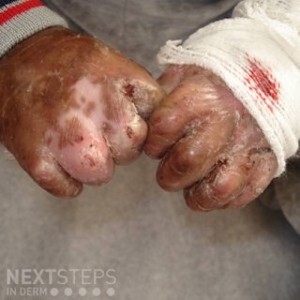
The correct answer is E: Recessive dystrophic epidermolysis bullosa.
The picture is shown is know as “mitten hands” and is diagnostic for recesseive type of dystrophic epidermolysis bullosa. RDEB have the Hallopeau-Siemens type, a severe life-altering bullous disease characterized by widespread dystrophic scarring and deformity and by severe involvement of mucous membranes. Much less commonly, RDEB may manifest as the non-Hallopeau-Siemens types, a mild localized form (mitis), and an inverse variant (recessive epidermolysis inversa). In the Hallopeau-Siemens form of RDEB, erosions and blisters are usually manifested at or shortly after birth. Blisters may appear to occur spontaneously, but most seem to arise at sites of pressure or trauma. Nikolsky sign is often positive. The hands and lower aspects of the legs are particularly susceptible to severe blistering and scarring. The fingers and toes may become fused, with resultant pseudosyndactyly, in which the digits become bound together by a glove-like epidermal sac, with resulting claw-like clubbing or mitten-like deformities as shown in the image.
Recessive dystrophic EB:
- May present with severe blistering (generalized severe RDEB) or mild disease (generalized intermediate RDEB)
- Generalized severe blistering is more common and involves large areas of skin and mucous membranes
- Blisters heal but with scarring and deformity causing limited movement as fingers and toes may be fused together (mitten hands)
- Complications such as infection, malnutrition and dehydration may cause death in infancy
- Those that survive are at great risk of developing potentially dangerous squamous cell carcinoma within chronic EB wounds. SCC look and behave differently in EB from in unaffected individuals. They are found on covered sites and grow rapidly. They present as ulcerated or keratotic nodules and plaques.
